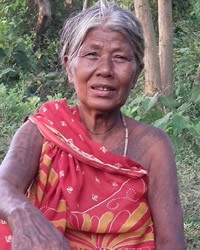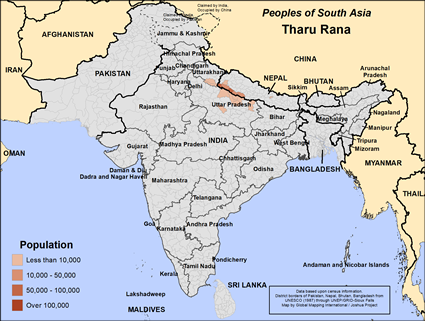The Tharu people live in the Tarai, a narrow strip of land which extends across 550 miles of the southern border of Nepal, next to northeast India. Tarai is forested and fertile but these forests are full of tigers and snakes and malarial swamps. The swamps kept outsiders away, and the Rana Tharu developed resistance to the malaria. Over the next four centuries they developed their own language and culture.
The Tharu people are divided into several subgroups; the Rana Tharu live in the southwestern corner of Nepal. A small number are over the border in Uttar Pradesh, India. Legend has it that after the Moguls invaded India in the 16th century, a Mogul king wanted to marry one of their women. The women and children fled east and settled in this forested region while their men stayed behind to fight the Moguls. When the women heard that all their men had been killed, they married the slaves who had attended them in their travels and settled permanently in their new home.
The Rana Tharu have lived quiet, simple lives for four centuries. Their village homes are plastered inside and out with mud and cow dung. They make almost everything they use themselves, with a touch of art in everything. Their walls are decorated with relief plaster sculpture and windows in geometric patterns. Their houses are large and communal; a family group lives together, and the women cook together, care jointly for their children and pass on their culture and traditions to the next generation. Their clothes are colorful and beautifully embroidered; they buy scraps of left-over fabric from the fabric merchant and each woman puts her own dress together in a unique and gorgeous fashion. They wear beautiful jewelry. They make their own clay pots cook stoves, woven baskets and fishing nets that look like butterfly wings.
Rice is their staple crop; they also grow corn. The men plow, plant and weave the nets that the women use to fish. They also hunt in the forest that is the backdrop to their neat fields and villages. The women plaster their houses and make the pots and baskets.
Their religion is animistic. They have their own gods and follow a bharra (shaman). Besides the Bharra, who treats their diseases, the village headman, bhalamansa, and the Desi-Mahajan - an Indian moneylender, are important people within the village.
Foreigners brought DDT in the 1950s and sprayed the swamps to get rid of the mosquitoes. Ironically, with the malarial pests gone, the culture has come under increasing pressure from the outside. Unscrupulous moneylenders have been able to get control of their land because of their illiteracy, and now many have to pay rent for land that they once owned. People from the hill country to the north are moving in and cutting down the protective forests. The large animals, the tigers and elephants, are becoming increasingly scarce.
There is increasing pressure to speak Nepali instead of Rana Tharu, and many of the children and men are wearing western clothes.
Even their houses are beginning to change, and they now build brick houses. Their traditional houses have no doors, but the new ones do. This is symbolic of the whole pressure to change coming to bear on these people. They are becoming more aware of outside issues and fireside chat in the evenings is becoming more outward focused, reflecting these changes.
New schools are coming to the villages, but the classes are taught in Nepali rather than Rana Tharu, and the parents are afraid their children will lose their language and culture. Similarly, more Rana Tharu people are adopting the Hindu religion rather than their traditional animistic beliefs.
Pray for the gospel to come to the Rana Tharu from loving Christ followers.
Pray the Rana Tharu people will have the spiritual hunger it takes to follow Christ no matter what it costs them.
Pray for the Lord to show himself powerful and righteous to Rana Tharu elders.
Pray for good medical care and improved medical clinics.
Scripture Prayers for the Tharu Rana in India.
https://communityhomestay.com/homestays/rana-tharu
https://www.recordnepal.com/five-misconceptions-about-rana-tharu-and-pan-tharu-identity
https://www.alamy.com/stock-photo/nepal-tharu-house.html?sortBy=relevant
https://www.hopnepal.com/homestays/rana-tharu-community-homestay-kanchanpur
| Profile Source: Joshua Project |












